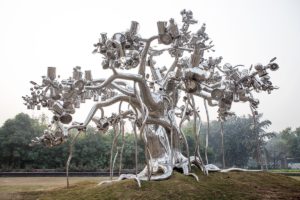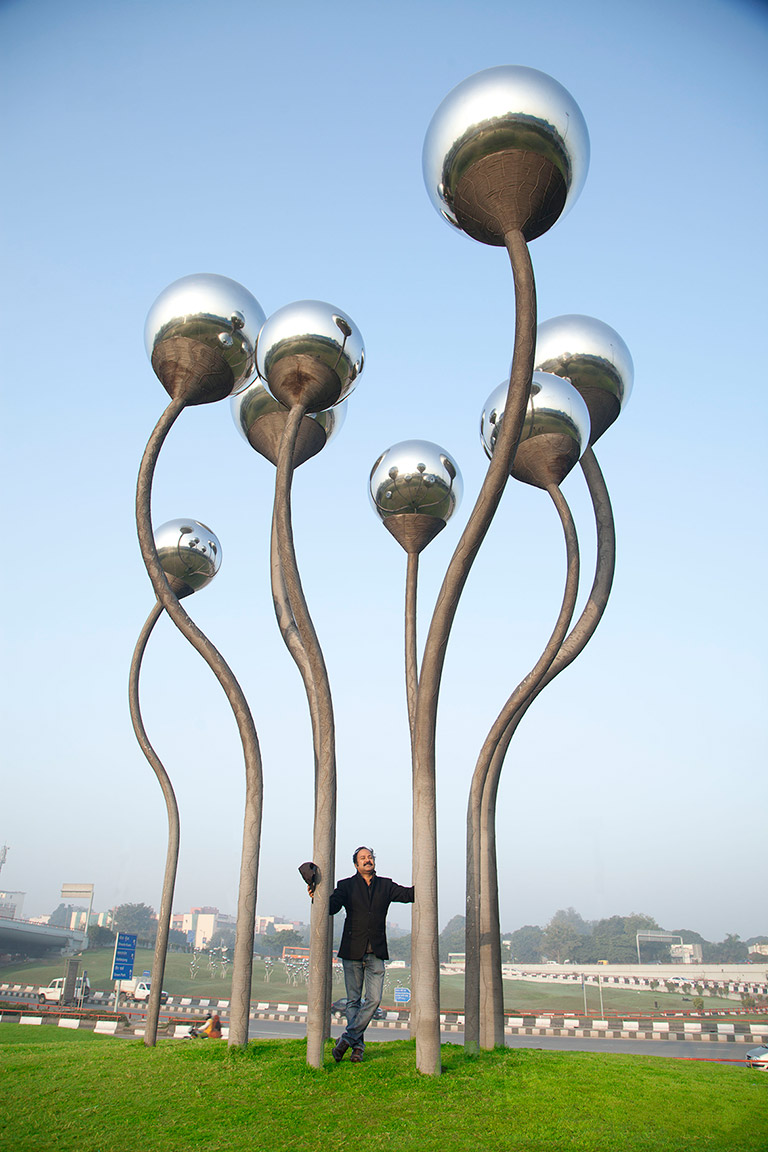Even though efforts have been made by artists to set up installations in the Capital, government policies and lack of public responsibility become a roadblock
Anyone living in the city would be familiar with the 35-feet high, mushroom-shaped steel sculpture near the AIIMS flyover. Spread over six acres, ‘Sprouts’ is India’s largest site specific public art installation and has invited mixed reactions over the years.
Created by Vibhor Sogani, as Delhi government’s initiative towards the beautification of the Capital, it has been over a decade since Sprouts was installed. Yet if one takes a look around the city, there has not been much development, so far as public art installations are concerned.
While the responsibility of the public towards these artworks has been an issue with reports of vandalism, the government policies too, need to be revamped to make it more conducive.
“To carry out any major project in public spaces, a system needs to be in place. The policies for display and installation of public art are obscure and complex and need to be addressed. The system and policies have to become simpler and more effective. Only then can we hope more public art displays in the country to make art more accessible for all,” says Sogani. He also adds that the DUAC are putting efforts in this regard.
In a discussion last year on ‘Public Art Policy, Guidelines and Master Plan for Delhi’, Union Minister Hardeep S Puri said, “Public art not only beautifies the cityscape, it also captures its soul.” The Delhi Urban Art Commission (DUAC) proposed guidelines which provide details of the type of art forms and locations where they can be installed; a list of approvals that are required and other installation specifications.

One must note that while the public art scene in Delhi has flourished quite well — the murals and wall paintings in Lodhi Garden speak for it — public installations, especially of stainless steel, are yet to take off in the city.
For a site-specific installation, there are several factors that come into play and perhaps deter its growth. “For the Sprouts installation, the process took almost a year, comprising initial conceptualisation to detailing of the installation, its placement in the larger landscape and the actual installation on the site. Various points, like vandalism, longevity, outer environment and maintenance, were kept in mind while working on it,” explains Sogani.
Recently, he has unveiled another installation in Dubai. So why are public installations not as popular in India as compared to the ones in US or other countries? “It will be incorrect to say that public art isn’t popular in our nation. It’s just that we haven’t seen enough of it,” he adds.
Taking a look at the global modern sculptures, it is stainless steel that is setting a trend. While there are Indian artists, like Anish Kapoor who is credited for The Bean in Chicago — one of the most celebrated steel sculptures in the world — there are fewer works of such artists that are displayed in India.
The few that are present are simply unmissable. For instance, Subodh Gupta’s Dada in NGMA, is a crowd puller just as it was meant to be. This iconic steel sculpture of a tree, with its leaves made by arranging stainless steel pots, pans, buckets and spoons in various shapes and sizes, is named Dada (grandfather), symbolising a family tree.
However, steel is quite a complex material to work with, admits Sogani. A new-age material, it requires an intelligent amalgamation of new technology and hand skills. “This is one of the reasons why there are not many large-scale steel sculptures in the country. Hopefully, we will see more of this in times to come.”
Agreeing with him, Deepika Jindal, director of Jindal Steel Limited Lifestyle (sponsor of Sprouts) says, “Stainless steel is a highly-engineered material which needs knowledge and know-how to work with.”
Deepika, who is also the founder of The Stainless Gallery in the city, believes that this material is becoming increasingly popular with artists. “If you look at the most iconic pieces of art, you’ll notice that stainless steel is a popular choice for public art, sculptures and outdoor features. Although the popularity among Indian artists is yet to reach greater heights, artists like Subodh Gupta have worked extensively with steel.”
However, things are changing surely, albeit slowly. “The market for stainless steel art has been blooming over the years in the contemporary steel art space. Today, the versatility and sheen of this metal offers a unique approach for contemporary art to tantalise the modern audience,” adds Deepika.
Sogani too, sees a brighter future for sculptural art in the coming days. “With the kind of infrastructural growth and development in India, we are bound to see an upsurge in this domain. I am confident that with the support of government bodies like the DUAC and increasing awareness in the art community, there will definitely be an upsurge in sculptural art,” he concludes.





